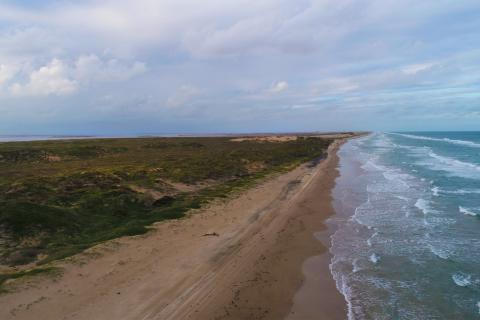With increasingly active tropical storm seasons in the western Gulf of Mexico, resiliency is at the forefront of conservation discussions. Fortunately, there is good news to share. In June, the Bahia Grande Coastal Corridor Habitat Acquisition project was completed.
The Bahia Grande project was included within the 2017 Texas Trustee Implementation Group’s Final Restoration Plan, and was co-implemented by the Department of the Interior and the Texas Commission on Environmental Quality. The project focused on the acquisition of the Holly Beach property consisting of tidal wetlands, thornscrub, and coastal prairie habitat on and adjacent to the Lower Laguna Madre in Cameron County, Texas. The 1,512 acre tract was added to the Laguna Atascosa National Wildlife Refuge to be managed by the U.S. Fish and Wildlife Service.
This area is vital for wildlife conservation as it is home to many federally endangered species, including five species of sea turtles, ocelots, jaguarundis, and nesting northern Aplomado falcons. Acquisition of the property also protects foraging habitat for migratory birds such as gull-billed terns, black skimmers, reddish egrets, piping plover, mottled duck, and red knot. Wildlife corridors will also be expanded through this acquisition, connecting the northern and southern units of the refuge. In total, Holly Beach is a coastal ecosystem that supports an abundance of wildlife and is vital to the coastal resilience of Texas’s coastline.
The acquisition was made possible by multiple funding streams and includes a large group of partners.
Partners working on the project include:
- The Conservation Fund
- U.S. Fish and Wildlife Service
- Peregrine Fund
- Texas Parks and Wildlife Department
- National Wildlife Refuge Association
- Deepwater Horizon Texas Trustee Implementation Group
Funding for the project included: $2.241 million of Deepwater Horizon NRDA dollars through the Texas Trustee Implementation Group; $2.86 million from Land and Water Conservation Fund through the U.S. Fish and Wildlife Service; and, $2 million from the National Fish and Wildlife Foundation Gulf Environmental Benefits Fund through The Conservation Fund. The Texas Trustee Implementation Groups funds for this project help restore the injury to wetland, coastal and nearshore habitats resulting from the Deepwater Horizon oil spill.
Within The Conservation Fund’s recent news release on the completion of the project, U.S. Fish and Wildlife Service’s Southwest Regional Director, Amy Leuders stated, “[c]oastal habitat conservation is critical to ensuring that our native wildlife and coastal communities remain resilient in the face of climate change, sea level rise, and the increased demand for land and water.”
Please visit the Texas Restoration Area webpage for more information on other ways habitat is being restored in the Lone Star State.


